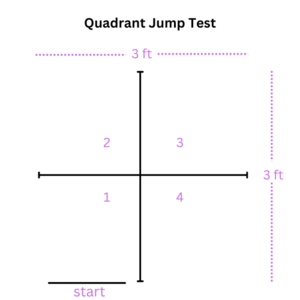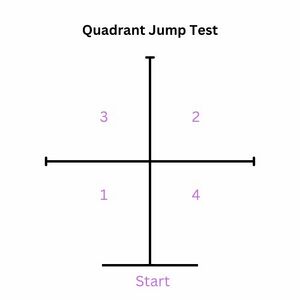Quadrant Jump Test
This article or area is currently under construction and may only be partially complete. Please come back soon to see the finished work! (17/06/2024)
Introduction[edit | edit source]
The Quadrant Jump Test is an agility test that measures an individual's ability to jump rapidly within a limited space while maintaining balance and control.[1]
Purpose[edit | edit source]
The Quadrant Jump Test is commonly used to test whole body agility of athletes from different sports.
Technique[edit | edit source]
Equipment: stopwatch, tape measure, chalk or tape
Testers:
- Tester 1- timekeeping
- Tester - counting total jumps
- Tester 3- recording test errors[3]
Instructions:
- Stand with both feet together at the starting line
- On the command 'go', jump into the first quadrant, then successively into quadrants 1, 2, 3, 4, 1, 2, and so on for 10 seconds[1][2]
- Rest
- Repeat the trial (Total of 2 trials are performed)
Advantages: Simple agility test to perform, requiring limited equipment and space.
Disadvantages: Only one person can perform the test at a time.[1]
Variations:
There's no standardised way of doing the test so there are differences in existing research:
- Some studies use 15 seconds for each trial[3]
- Quadrant jumps may be performed following Figure 1 or Figure 2.
- The test can also be done in anticlockwise directions to show if imbalances exist between an athlete's left and right movement performance.
Scoring[edit | edit source]
- 1 point is given every time both feet land in the right quadrant
- 0.5 point is subtracted every time the feet touch a line or land in an incorrect quadrant.
- There are 2 ways to compute the final score:
Evidence[edit | edit source]
There are limited studies measuring the validity and reliability of the Quadrant Jump Test[4]
- ↑ 1.0 1.1 1.2 1.3 1.4 Johnson, B.L.; Nelson, J.K. IN: Kirby, R. F. (1991). Kirby's guide to fitness and motor performance tests. BenOak Pub. Co. Cape Girardeau, MO. Page(s) 59-60.
- ↑ 2.0 2.1 2.2 Jakiwa J, Rustam S, Atan SA, Azli MS, Maliki AB, Nadzmi A, Rahman AF, Samsir MS, Sun Z, Kuo PT, Bee NC. The Effects of Multi-Sport Intervention on Agility Performance among Young Athletes. International Journal of Human Movement and Sports Sciences. 2023;11(4):864-71.
- ↑ 3.0 3.1 Hu C, Sun Y. The influence of football training based on big data on physical function and football skills. Mobile Information Systems. 2022;2022(1):1735022.
- ↑ Bashir M, Soh KG, Samsudin S, Akbar S, Luo S, Sunardi J. Effects of functional training on sprinting, jumping, and functional movement in athletes: A systematic review. Frontiers in physiology. 2022 Nov 30;13:1045870.








